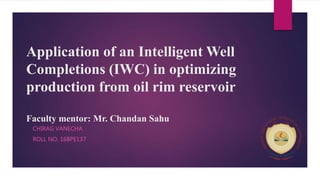
Optimizing Oil Production from Thin Oil Rim Reservoirs Using IWC
- 1. Application of an Intelligent Well Completions (IWC) in optimizing production from oil rim reservoir Faculty mentor: Mr. Chandan Sahu CHIRAG VANECHA ROLL NO. 16BPE137
- 2. What is an Oil Rim reservoir?? The oil part of gas/oil or oil/gas/condensate deposit, the size and geological reserves of which are significantly smaller than of the gas part of the two-phase deposits. An oil rim reservoir is a saturated reservoir with an oil column of limited thickness, less than 90 feet, overlain by a gas cap with a thickness of more than 250 ft and underlain by an aquifer. and despite their low pay thickness they can still contain substantial volumes of hydrocarbon-in-place.
- 3. Intelligent well completions An intelligent well is defined as an advanced well equipped with intelligent completion technology. An intelligent well completion is a system equipped with sensors and special valves installed on the production tubing, which provides the operator with continuous monitoring and adjustment of fluid flow rates and pressures. It is challenging to increase oil recovery from reservoir with thin oil rim and more gas after a long depletion of gas cap. Judicious selection of intelligent completions will increase oil recovery and constrain unwanted water and gas production from the reservoir.
- 4. IWC reduce CAPEX and OPEX and help in increasing additional productivity than conventional completions. The nature of oil rim reservoirs makes long horizontal wells an attractive option for increasing well-reservoir contact and reducing drawdown. It can be achieved by using Inflow Control Valves (ICV) installed on the production tubing. The production of oil and gas is highly dependent on types of ICDs and ICD configuration. Therefore, choosing the best ICD is a key point to maximize the oil production.
- 5. Challenges while production Among the various challenges encountered in producing oil rim reservoirs, water and/or gas coning and breakthrough is the most prominent. The production of unwanted well fluids, such as water or gas, impacts well and reservoir performance and its financials. Inter-well connectivity, formation fluid movement and understanding whether unwanted fluid comes from the formation or nearby wells play an important role in different reservoir development planning stages. Water and gas breakthrough occurs majorly due to heel-toe effect and reservoir permeability variations. Inflow control devices (ICDs) were deployed to mitigate the heel-toe effect thereby delaying the water and gas breakthrough.
- 6. Water and gas coning Coning is a rate-sensitive phenomenon generally associated with high producing rates. Strictly a near-wellbore phenomenon, it only develops once the pressure forces drawing fluids toward the wellbore overcome the natural buoyancy forces that segregate gas and water from oil. The change in the oil-water contact profile as a result of drawdown pressures during production. Fig 1: (b) a producing well subject to gas and water coning Fig 1: (a) a producing well with no coning
- 7. Coning (ctd.) Fig 2: (a) coning in a vertical well Fig 2: (b) coning in a horizontal well
- 8. Factors affecting coning Density differences between water and oil, gas and oil, or gas and water (gravitational forces) Fluid viscosities and relative permeabilities Vertical and horizontal permeabilities Distances from contacts (oil-water/gas-water) to perforations.
- 9. Heel-Toe effect Fig 3: Heel and toe part in the production tubing
- 10. Heel-Toe effect (ctd.) Increasing the horizontal wellbore length leads to some production challenges. In a long horizontal well with open hole completion, the drawdown in the heel section of a well is much higher than the drawdown in the toe section. This is because of higher cumulative frictional pressure loss in the heel section than the toe. Thus, higher production in the heel section than the toe section is expected. Consequently, the inflow from the reservoir to the well and water/gas breakthrough are non-uniform. This phenomenon gives partial water or gas breakthrough and lower oil recovery and sweep efficiency.
- 11. Fig 4(a): coning in horizontal wells Fig 4(b): even drainage with ICD The area close to the heel will produce more hydrocarbons, resulting in coning of the water-oil contact or the gas-oil contact. Over the time, this leads to reduction in oil production and more water disposal problems.
- 12. ICV- inflow control valves Fig 5: Intelligent well completion with Autonomous ICDs
- 13. How do ICVs or ICDs work? As it is shown in figure 4 by arrows that fluid first flows along the base pipe and enter through the outer screen then flows through nozzles and comes in the wellbore. After passing through the screens, it goes to the chamber then flows since flow rate is controlled by orifices present over there. This controlled flow by orifices and sensors comes under ICDs. Fig 6: channel ICD schematics
- 14. Sensors send heel toe effect reduction in the form of non-linear, second order ODE. And solutions must allow one to estimate that: 1)ICD design parameters that reduce heel-toe effect at required level and 2) impact of ICD’s on the well’s inflow performance relationship. ICDs or AICDs generally have hydrophobic part in them so these devices keep away water to enter in the wellbore. So multiple ICDs throughout the horizontal well length keep water level at some distance and help in producing only oil. ICVs (ctd.)
- 15. Autonomous Inflow control device
- 16. References: Ali Mojaddam Zadeh et. Al., “Optimal inflow control devices configurations for oil rim reservoirs”, 2012. I. Chaperon., “Theoretical Study of Coning Toward Horizontal and Vertical Wells in Anisotropic Formations: Subcritical and Critical Rates” https://www.iprojectmaster.com/MARINE%20ENGINEERING/final-year- project-materials/application-of-intelligent-well-completion-in-optimizing- production-from-oil-rim-reservoirs Bernt S. Aadnoy et. Al., “Analysis of Inflow control devices”, 2009, SPE international Schlumberger oilfield glossary, Wikipedia and Petrowiki
